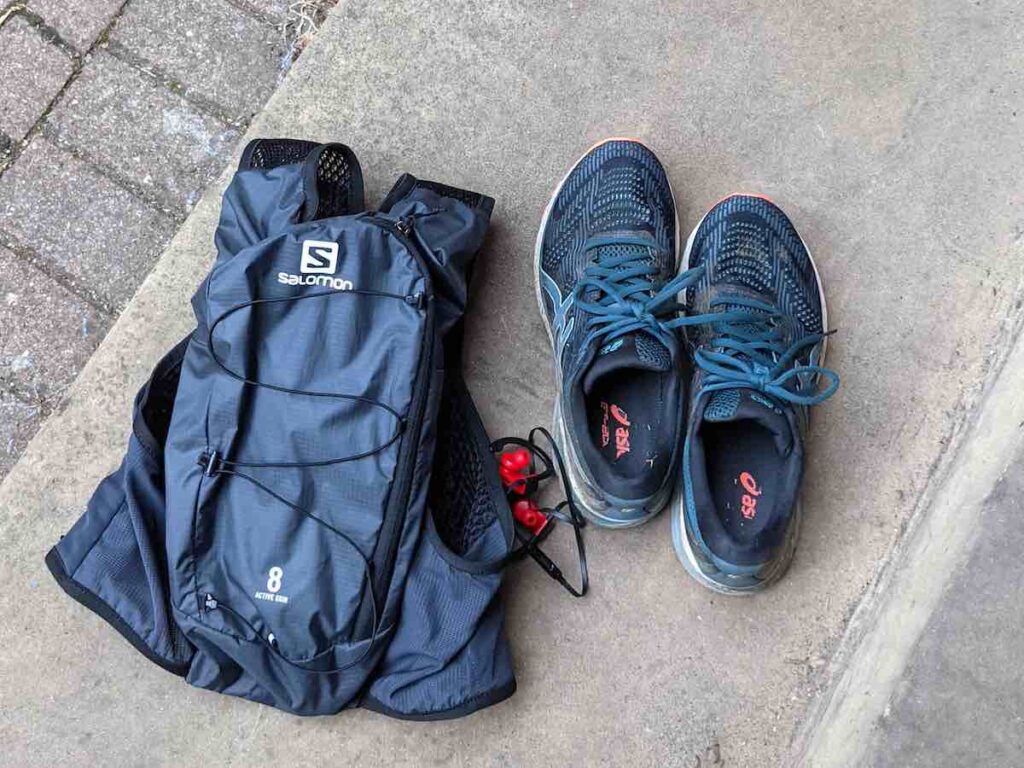As temperatures rise in Summer, the hot weather doesn’t have to dwindle your appetite for outdoor running. In fact, running in hot weather can be both enjoyable and beneficial to your fitness, as long as you take the appropriate precautions.
In this article we’ll go through some great tips to maintain a regular running routine during the hottest days without compromising your health and safety.
But first, some of the benefits of summer runs…
Heat Benefits: Why I Love Running in Hot Weather
- Lighter mornings and longer days
- Running with fewer layers on
- More organized runs and races
- More personal bests (PBs) are made in summer
- Easier to find a running partner
- The restorative sun’s rays on your back
- Being immersed in nature and finding shade in woodland or tree-lined paths
- Better pit stops – ice cream on a hot day!
In summary, running in hot weather is a treasure trove of joy and accomplishment (check out the full list of benefits of jogging in the Summer). But it’s not without frustrations or safety fears either…
Understanding the Risks of Running in Hot Weather
How to spot and treat the main heat-related illnesses when running or jogging.
Heat Exhaustion from Running
Heat exhaustion occurs when your body cannot cool itself adequately at high temperatures. Running in extreme heat for extended periods may cause you to feel weak, dizzy, and nauseous. To prevent heat exhaustion, wear lightweight and moisture-wicking clothing, take breaks in shaded areas, and stay hydrated.
Heat Stroke from Running
Heat stroke is a more severe condition than heat exhaustion and requires immediate medical attention. Symptoms include high core body temperature, confusion, and rapid breathing. To lower your risk of heat stroke, avoid running during peak heat hours, acclimate gradually to running in the heat, and hydrate consistently.
Dehydration from Running
Dehydration happens when your body loses more water than it takes in. While running in hot weather, it’s crucial to drink water regularly and monitor your urine color. Carry a cold water bottle or running backpack during your run. These days, there’s plenty of cafés and restaurants that will let you top up your own water bottle or supply for free.

However, speaking from experience, supplies might be more limited on a trail run. I made the silly mistake of not taking enough water on my Hadrian’s Wall ultra run.
Heat Cramps from Running
Muscle cramps can occur when your muscles lose electrolytes through excessive sweating. To prevent cramps while running in hot weather, sip on a sports drink containing electrolytes, like sodium and potassium, and pace yourself according to the heat index.
How to Recognize Early Signs of Heat Illness
While running in blistering Summer, heat and humidity, it’s essential to be aware the early signs of heat illnesses. These include:
- Excessive sweating
- Dizziness and lightheadedness
- Nausea
- Rapid heart rate
- Headache
- Sunburn
Understanding and addressing these symptoms promptly is vital to reduce the risks associated with running in hot weather and stop them in their tracks before they do serious harm, or even become life threatening.
Remember to always listen to your body and make necessary adjustments to your training schedule in the sun, which is where we’ll turn our attention next.
My Top Tips for Running in Hot Weather
Good news: you can enjoy all the benefits of running in warmer temperatures and humid conditions with some basic preparation and tweaks to your training.
Wear Appropriate Summer Running Clothing
Wear lightweight, sweat-wicking, and breathable clothing in high heat. This helps to keep your body temperature regulated and prevent overheating. Opt for light colors, as they reflect sunlight and keep you cooler. Additionally, choose loose-fitting clothes to allow better air circulation around your body.
Check out what I packed when running my last ultra over multiple hot summer days (Hadrian’s Wall packing list).
Develop Smarter Hydration Strategies
Proper hydration is crucial when running in the the heat and humidity. Make sure to:
- Drink water frequently before, during, and after your run
- Include sports drinks with electrolytes to replenish what you lose through sweat
- Carry water in a hydration pack on longer runs (complete with snacks!)
- Use Refill or similar ‘app for tap’ for free refill stations
- Keep your soft water bottles in the freezer overnight

Sun Protection in High Temperatures
Protect yourself from the sun’s harmful UV rays:
- Wear a hat with a brim or a visor to shield your face
- Apply and carry a spots sunscreen with an SPF of 30+
- Seek shade whenever possible during your run
- Take it in turns with your running buddy to carry the essentials
Dial Down Your Running Pace and Effort
- Run slower, especially during the hottest parts of the day
- Monitor your heart rate and decrease your effort if it spikes unexpectedly
- Take walk breaks or rest up altogether under a big tree
- Listen to your body and take breaks when needed
- Embark on more awe runs and enjoy everything Summer has to offer
- Speed everything up with speed workouts
- Ask your personal trainer for a bespoke hot weather training plan
- Plan shorter routes, savoring the joy of running in smaller doses
Avoid running in the hottest parts of the day
Plan to run early in the morning or jog at night to avoid peak temperatures. This also has the added benefit of quieter routes and less car pollution. Alternatively, be ready to strike at a moments notice to run when it starts raining.
Best Times and Locations for Running in the Heat
Morning and Evening Runs
To avoid the intense heat of the day, it’s best to schedule your runs during the cooler temperatures of early mornings or evening hours. Mornings are typically cooler than evenings, providing a refreshing start to your day. Setting out just after sunrise allows you to take advantage of the lower temperatures and reduced humidity. Evening runs can also offer relief from the heat, but be mindful of the lingering warmth and higher humidity levels that may still be present.
Selecting Shaded Routes – Woodland and Built Up Areas
Stay cool by running through parks with tree cover, on grassy trails, or even under the cover of buildings in urban areas can provide protection from the sun. Members of clubs like the Road Runners Club of America can share their favorite shaded routes, making your search for the perfect spot easier.

While running in the shade, be aware of the surfaces you’re traversing. Grass offers a softer and cooler experience underfoot compared to asphalt or concrete. Be cautious when transitioning between surfaces, as the terrain may affect your stride and overall running experience. Always try to find a route that provides a balance of shade and a comfortable surface to run on.
During your run, pay attention to the direction of the breeze to help keep you cool. Ideally, choose a route that allows you to run into the wind during the hottest sections of your course. This natural cooling method can make a significant difference in your overall comfort and performance in hot weather.
Recognizing and Responding to Heat-Related Symptoms
Warning Signs
During hot weather runs, be aware of heat-related symptoms that include headache, nausea, cramps, and dizziness. These are signs that your body is struggling to cope with the heat. It’s crucial to slow down and take precautionary measures when you experience any of these symptoms:
- Headaches can also be a sign of heat exhaustion. Ensure that you’re wearing sun protection, hydrating properly, and taking breaks to reduce your core temperature.
- Nausea and muscle cramps can be an indicator of dehydration and electrolyte imbalances. Keep drinking fluids, preferably with electrolytes, to maintain a proper hydration level.
- When you feel dizzy or lightheaded, it’s time to take a break. Look for a shaded area and sit down for a moment while gradually sipping water to regain your balance.
When to Seek Medical Attention
Seek medical attention if you notice severe symptoms, such as:
- Difficulty breathing
- Fainting or loss of consciousness
- Severe vomiting
- Chest pain
- Extremely high body temperature
These symptoms can indicate more serious conditions like heat stroke or heat exhaustion, which require immediate medical attention. Remember to prioritize your health and safety during hot weather runs, wear sunscreen, and pay close attention to your body’s signals.
Frequently Asked Questions
To run safely in hot conditions, always begin by checking the air temperature and humidity levels. Schedule your run in the cooler parts of the day, like early morning or late evening, and avoid running during peak heat hours. Choose well-shaded routes and remember to apply sunscreen. Gradually increase your exposure to heat and stay tuned with your body, taking breaks when needed.
Running in the heat increases the risk of dehydration, heat exhaustion, and heat stroke. Some signs of heat exhaustion include excessive sweating, paleness, dizziness, nausea, and rapid heartbeat. Heat stroke is a more severe condition, and symptoms may include high body temperature, mental confusion, lack of sweating, and unconsciousness. If you experience any of these symptoms, stop running and seek immediate medical attention.
Yes, heat can negatively affect your running performance. As your core body temperature increases, blood flow is redirected to the skin to cool down, which may lead to reduced oxygen supply to the muscles and increased heart rate. These factors can cause you to feel fatigued and make it harder to maintain your typical pace or distance.
Staying hydrated is crucial when running in hot weather. Drink at least 16-20 oz of water 1-2 hours before your run, and another 8 oz right before you start. During your run, aim to consume 6-8 oz of water every 20 minutes. After finishing your run, drink enough water to replenish any lost fluids.
Wear lightweight, breathable, and moisture wicking fabrics to keep you cool and dry during hot weather running. Avoid wearing dark colors, as they tend to absorb sunlight and may make you feel hotter. Opt for light clothing and a hat or visor to shield your face, and wear sunglasses to protect your eyes from the sun.
Adjusting your running pace in hot weather is necessary to prevent overheating. As a general rule, slow down by 30-60 seconds per mile for every 5°F above 60°F. Pay attention to your body and adjust your pace accordingly: slowing down when you feel overheated and maintaining a comfortable pace throughout the run. Remember, your primary focus should be on safety and preventing heat-related complications.

